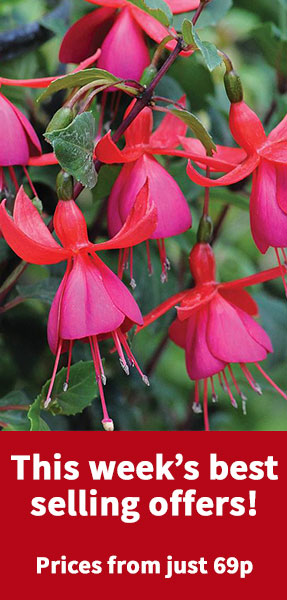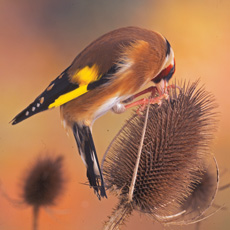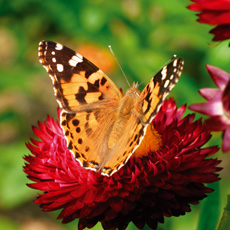
Plants for wildlife
There are so many benefits to attracting wildlife into your garden. Apart from saving the decline of our native species, garden wildlife also acts as a natural pest control, preventing the need to spray harmful chemicals all over your garden. If you grow fruit and vegetables, you’ll need the help of bees to pollinate many of your crops. Contrary to popular belief wildlife gardens needn’t be messy! Well-maintained hedges and shrubs are perfect for nesting birds and insects, and a flowing herbaceous border will attract all sorts of beneficial insects to your garden. You could even create a container garden for wildlife with some of the plants listed below! Planting a wildlife garden couldn’t be easier; read on for more ideas on how to make a wildlife garden.
Plants for bees
The number of bees in the UK is declining at an alarming rate, yet there are few explanations. It's suggested that the decline in native and wild flower rich grassland could be a cause. Bees play a key role in pollinating many crops and some 35 per cent of our diet depends on pollination of crops by bees! Bees are active between February and October and it is crucial they have enough food during this time to help them through the winter and early spring. You can help by creating a wildlife garden and choosing a selection of the plants for bees listed below. For more information on how you can help bees take a look at our ‘Save the Bees’ article.
Plants for butterflies
There are 58 species of butterfly native to the UK and many of these are under threat of extinction. Recent reports have shown, however, that recent conservation efforts have given some of our most threatened species a boost. You can do your bit to help the butterflies by planting nectar-rich flowers in your garden. Take a look at the list below for inspiration. For more information on helping butterflies take a look at our ‘Helping to conserve the UK’s butterflies’ page.
Plants for birds
Birds are welcome visitors to the garden and will eat aphids, caterpillars and slugs for you! You can attract birds into your garden by installing a bird bath and by putting out extra food throughout the harsh winter months. You can also grow a wide range of plants for birds, which produce berries, seeds or nuts at the end of the season. Plants can also be used to provide shelter or nesting sites for birds, protecting them from cats and other predators.
For more simple ideas on how you can attract wildlife to your garden take a look at our article about wildlife gardening.
Top tips when planting for wildlife:
- Choose single-flowered varieties of plants. Bees and butterflies can’t access double flowers for pollen and nectar.
- Leave some of your culinary herbs to flower - they are a rich food source for bees and butterflies and will leave your garden buzzing on warm days!
- Leave your autumn clear up until the spring. The dead remains of plants provide valuable shelter for over-wintering insects.
- Try not to spray your plants with insecticides as these will kill beneficial insects too. Be patient and the pests will often be eaten naturally by ladybirds, lacewings, spiders, small mammals and birds.
Spring flowering plants for attracting wildlife
| Spring flowering plants for attracting widlife |
Attracts |
Attracts |
Attracts |
Interesting Features |
|---|---|---|---|---|
| Fruit trees e.g. Apple, Cherry, Plum, Pear and Almond trees | ||||
| Crab apple | ||||
| Quince | ||||
| Blackcurrants/Redcurrants | ||||
| Gooseberries | ||||
| Alyssum ‘Golden Queen’ | ||||
| Aquilegia | ||||
| Aubrieta | ||||
| Berberis | ||||
| Bergenia | ||||
| Bluebells | ||||
| Crocus | ||||
| Daphne mezereum | ||||
| Flowering Currant | ||||
| Forget-me-not | ||||
| Hawthorn | ||||
| Holly | ||||
| Honesty | ||||
| Muscari | ||||
| Pyracantha | ||||
| Pulmonaria | ||||
| Mahonia aquifolium (Oregon Grape) | ||||
| Heather | ||||
| Sorbus aucuparia (Rowan) | ||||
| Snowdrop | ||||
| Wallflower | ||||
| Wisteria |
Summer flowering plants for attracting wildlife
| Summer flowering plants for attracting widlife |
Attracts |
Attracts |
Attracts |
Interesting Features |
|---|---|---|---|---|
| Raspberries/blackberries | ||||
| Broad beans | ||||
| Runner beans | ||||
| Alyssum | ||||
| Allium | ||||
| Borage | ||||
| Campanula | ||||
| Chives | ||||
| Cornflower | ||||
| Echium | ||||
| Fennel | ||||
| Foxglove | ||||
| Geranium | ||||
| Hebe | ||||
| Helenium | ||||
| Heliotrope | ||||
| Lavender | ||||
| Lime tree | ||||
| Lupin | ||||
| Marigold | ||||
| Monarda | ||||
| Monkshood | ||||
| Phacelia | ||||
| Phlox | ||||
| Rosa canina & Rosa rugosa | ||||
| Stipa tenuissima (Mexican Feather Grass) | ||||
| Sweet William | ||||
| Verbena bonariensis | ||||
| Sage | ||||
| Rosemary | ||||
| Thyme | ||||
| Oregano |
Late summer/autumn flowering plants for attracting wildlife
| Late summer/autumn flowering plants for attracting wildlife |
Attracts |
Attracts |
Attracts |
Interesting Features |
|---|---|---|---|---|
| Aster ‘Composition’ | ||||
| Agastache foeniculum | ||||
| Buddleja | ||||
| Catmint | ||||
| Dahlia (single-flowered varieties) | ||||
| Echinacea | ||||
| Eryngium | ||||
| Escallonia | ||||
| Echinops | ||||
| Eupatorium maculatum | ||||
| Hebe | ||||
| Hollyhock (single-flowered varieties) | ||||
| Ivy | ||||
| Lavatera (Mallow) | ||||
| Honeysuckle | ||||
| Panicum | ||||
| Scabious | ||||
| Sedum | ||||
| Sunflower | ||||
| Teasel | ||||
| Verbena bonariensis |
Looking for more tips and tricks? Check out our 'gardening for wildlife' resources for advice on all things wild!

Written by: Sue Sanderson
Plants and gardens have always been a big part of my life. I can remember helping my Dad to prick out seedlings, even before I could see over the top of the potting bench. As an adult, I trained at Writtle College where I received my degree, BSc. (Hons) Horticulture. After working in a specialist plantsman's nursery, and later, as a consulting arboriculturalist, I joined Thompson & Morgan in 2008. Initially looking after the grounds and coordinating the plant trials, I now support the web team offering horticultural advice online.
Sign Up For Exclusive Special Offers




© 2024 Thompson & Morgan. All rights reserved. A division of Branded Garden Products Limited.







